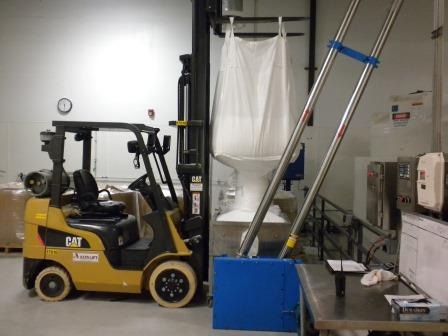Loading Materials via an Aeromechanical Conveying System
May 22, 2014

A properly designed aeromechanical conveyor system is a proven machine. It was invented in 1959, specifically for the purpose of conveying peanut halves. Since then, it has broadened its ability to convey all types of flakes, granules, and powders in a dust-contained and hygienic manner. It is the rope assembly's speed that allows the versatility of all dry bulk solid materials to convey through the machine. Nevertheless, the successful use of an aeromechanical conveyor system within a production plant requires that the dry bulk solid material loading process be set up correctly. In order to accomplish this, it is important to keep the following criteria in mind:
Operates Virtually Empty
An aeromechanical conveyor system is lightly loaded when conveying a dry bulk solid material. With the rope assembly traveling at an appropriate speed, the discs divert the air through which they are traveling within the tubes to create draft pockets. The material particles are carried within these draft pockets for the short duration they are within the unit. As a result, the throughput rate is very high with the least amount of HP use.
Material Flow Regulation
The aeromechanical conveyor requires a flowing stream of material into its feed housing. The material source's package type shall dictate the type of equipment (if any) to be utilized for this function (i.e. operator hand dumping small bags, screw conveyor, screw feeder, volumetric feeder, belt conveyor, vibratory conveyor, etc.).
Destination Volume
The destination vessel must be of sufficient volume to hold the entire batch amount of material to be loaded through the aeromechanical conveyor system.
Balanced Process
The aeromechanical conveyor system is a balanced process within itself. The material exiting the unit displaces an equivalent volume of air from the destination vessel back to its inlet.
What Goes in, Goes out
Leftover material within an aeromechanical conveyor system is negligible. It is essentially empty and ready for the next loading cycle. Nevertheless, should the small film thickness of leftover material need to be cleaned out, this is easily accomplished by blowing compressed air into the aeromechanical conveyor's inlet while the unit is running for approximately five seconds, or circulating water through it.
Maintenance
Made up of the wire rope and molded discs, the rugged rope assembly is designed to handle the instantaneous light load of material within the unit. The minor amount of wire rope stretch is easily adjusted, when needed.
Operates at Any Incline
The aeromechanical conveyor system's incline can be anything from horizontal to vertical. It is the rope assembly speed that is critical to the function of the unit. In addition, multiple units can be situated in series to accommodate a particular plant layout.
In summary, all bulk solid materials are received at a plant on the ground floor, yet the manufacturing process inlet location is at an elevation. The aeromechanical conveyor system is a proven and versatile unit that elevates any flake, granule, or powder material with reliability and virtually no maintenance. Its standard design allows for an easy fit into the plant layout criteria. And, it loads the material quickly, so that the manufacturing process can have a surge of material awaiting its use. The operator can then go and do other tasks before another material load needs to be elevated. Let the aeromechanical conveyor system raise the bulk solid material to the elevations required within your plant.
Larry Blitz is president of FloAero Inc., (Encino, CA) which began in 1997 to distribute the Floveyor Aeromechanical Conveyor and systems of equipment associated with the conveyor for the processing of bulk powders, flakes, and granules. Blitz has 34 years of experience in the bulk solids handling industry, as well as a chemical engineering degree from Purdue University. Contact him at 818-789-0546 www.floaero.com.
For related articles, equipment reviews, and news, visit our Mechanical Conveying Equipment Zone
You May Also Like

